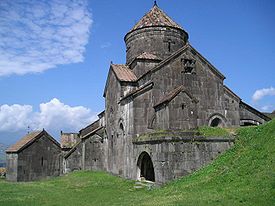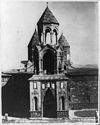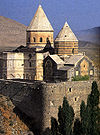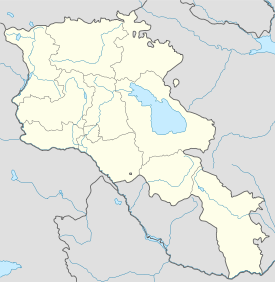- Haghpat Monastery
-
Monasteries of Haghpat and Sanahin
UNESCO World Heritage Sites
Հաղպատավանք
The Church of Sourb Nshan at Haghpat Monastery
Basic information Location Haghpat, Lori Province,
 Armenia
ArmeniaGeographic coordinates 41°05′38″N 44°42′43″E / 41.093889°N 44.711944°ECoordinates: 41°05′38″N 44°42′43″E / 41.093889°N 44.711944°E Affiliation Armenian Apostolic Church Architectural description Architectural style Armenian Groundbreaking 10th century UNESCO World Heritage Site Official name: Monasteries of Haghpat and Sanahin Type: Cultural Criteria: ii, iv Designated: 1996 (20th session) Reference #: 777 Region: Europe and North America Haghpat Monastery, also known as Haghpatavank ("Հաղպատավանք" in Armenian), is a medieval Armenian monastery complex in Haghpat, Armenia.[1]
Described as a "masterpiece of religious architecture and a major center of learning in the Middle Ages", this venerable institution of the Armenian Apostolic Church was placed on UNESCO's World Heritage List in 1996.[2]
The monastery was founded by Saint Nishan (Sourb Nshan) in the 10th century during the reign of King Abas I. The nearby monastery at Sanahin was built around the same time.[3]
The monasteries at Haghpat and Sanahin were chosen as UNESCO World Heritage Sites because:
The two monastic complexes represent the highest flowering of Armenian religious architecture, whose unique style developed from a blending of elements of Byzantine ecclesiastical architecture and the traditional vernacular architecture of the Caucasian region.[1]
The location of Haghpat Monastery was chosen so that it overlooks the Debed River in northern Armenia's Lori region. It was built, not on a peak, but halfway up a hillside on a site chosen to afford protection and concealment from prying eyes and also in response to a kind of monastic humility. It is built on a verdant promontory located in the middle of a mountain cirque, which is often wreathed in clouds. A peak on the opposite side of the river is over 2,500 meters high. The monasteries of northern Armenia are not isolated, unlike their counterparts in the country's arid regions. They were built in a village environment and Haghpat is surrounded by many hamlets.[2]
The small church of St. Nishan is Haghpat's earliest surviving building. It was begun in 966-67 and was later enlarged and embellished under the direction of Trdat the Architect.[2]
The largest church in the complex, the Cathedral of St. Nishan, was built from 967-991. It is a typical example of tenth century Armenian architecture, its central dome rests on the four imposing pillars of the lateral walls. The outside walls are dotted with triangular recesses. A fresco in the apse depicts Christ Pantocrator. Its donor, the Armenian Prince Khutulukhaga, is depicted in the south transept (a transversal nave intersecting the main nave). The sons of the church's founder, Princes Smbat and Kurike, are shown with Queen Khosravanuche in a bas-relief on the east gable. Apart from one or two minor restorations carried out in the eleventh and twelfth centuries, the church has retained its original character.
There are several other structures at the site as well. There is the small domed Church of Sourb Grigor (St. Gregory ) from 1005. Two side chapels were added to the original church; the larger one built in the beginning of the 13th century and the smaller, known as "Hamazasp House", built in 1257. In 1245, a three-story tall free-standing belltower was constructed. Other 13th century additions include the chapel of Sourb Astvatsatsin, the scriptorium, and a large refectory which is outside of the monastery limits.[4]
There are also a number of splendid khachkars (cross-stones) of the 11th-13th centuries standing on the territory of the monastery, the best known among them is the "Amenaprkich" (All-Savior) khachkar which has been standing since 1273.[4]
The monastery has been damaged many times. Sometime around 1130, an earthquake destroyed parts of Haghpat Monastery and it was not restored until fifty years later. It also suffered numerous attacks by armed forces in the many centuries of its existence and from a major earthquake in 1988. Nevertheless, much of the complex is still intact and stands today without substantial alterations.[2][4]
Today the area is an increasingly popular tourist site.
Gallery
References
External links
- Haghpat at Armenica.org
- Armeniapedia.org entry on Haghpat
- UNESCO entry on Haghpat and Sanahin
- "The monastery of Haghpat" by Elisabeth Baudourian, UNESCO Courier, May 1998
- Haghpat Photos at Mayrhayasdan.com
 Historical Armenian monasteries and churches
Historical Armenian monasteries and churches 
Republic of Armenia Aghjots Vank · Akhtala · Arakelots · Arates · Areni · Artavazik · Aruchavank · Askipari · Avan · Ayrk · Bardzrakash · Bgheno-Noravank · Byurakan · Chiki Vank · Daputs · Ddmashen · Deghdznuti · Dvin · Etchmiadzin Cathedral · Gayane · Geghard · Gharghavank · Gladzor · Gndevank · Goshavank · Haghartsin · Haghpat · Harichavank · Havuts Tar · Hayravank · Hnevank · Horomayri · Hovhannavank · Hripsime · Irind · Jukhtak Vank · Kaptavank · Karapet · Karbi · Karmravor · Kasagh · Katoghike · Kecharis · Khor Virap · Khorakert · Khoranashat · Khuchapi · Kirants · Kobayr · Kotavank · Kristapori Vank · Lmbatavank · Makaravank · Makenyats Vank · Makravank · Saint Mariane of Ashtarak · Marmashen · Mashtots Hayrapet · Mastara · Matosavank · Mshkavank · Mughni · Nor Varagavank · Noraduz cemetery · Noravank · Odzun · Oshakan · Pemzashen · Ptghavank · Surb Poghos-Petros · Saghmosavank · Samsoni · Sanahin · Saint Sargis of Ashtarak · Sevanavank · Shativank · Shkhmuradi · Shoghakat · Spitakavor of Ashtarak · Srveghi · Talin · Tanahat · Targmanchats Vank · Tatev · Tatevi Anapat · Teghenyats · Tegher · Tegh · Tsakhats Kar · Tsaghkevank · Tsiranavor of Ashtarak · Tsovinar · Ushi · Vahanavank · Vahramashen · Vanevan · Vorotnavank · Voskevaz · Yeghipatrush · Yeghvard · Yererouk · Zorats · Zoravor · Zvartnots 

Nagorno-Karabakh
Republic (Artsakh)Amaras · Bovurkhanavank · Dadivank · Gandzasar · Gtichavank · Tsitsernavank · Yeghishe Arakyal · Yerits Mankants Azerbaijan Saint Sargis Monastery of Gag · Targmanchats · Nakhichevan: Julfa cemetery List of Armenian churches in Nakhchivan Georgia (country) Holy Mother of God (Mens) · Norashen · Bethlehem St. Astvatsatsin · Armenian Cathedral of Tbilisi · Vera St. Cross · Krtsanis Tsiranavor Surb Astvatsatsin (Geghardavank) · Jigrasheni Avetyats church · Dzorabash St. Gevorg · Zrkinyants St. Gevorg · Kamoyants St. Gevorg · Kuky St. Astvatsatin · Mughni St. Gevorg · Navtlukh St. Gevorg · St. Gevorg · St. Grigor Lusavorich · St. Karapet · St. Minas · Tandoyants St. Astvatsatsin · Hreshtakapetats · Chugureti St. Astvatsatsin Iran Dzor Dzor · Holy Mother of God · Saint Stepanos · Saint Thaddeus New Julfa: Church of Bethlehem · Holy Mother of God · Saint Catherine · Saint Gregory · Saint Minas · Saint Nicholas · Saint Sarkis · Saint Stepanos · Vank Cathedral Israel Cathedral of St. James · Church of the Archangels · St. Toros Church · Chapel of Saint Helena · Saint Nicholas Monastery Turkey Aghtamar · Aprank · Arter · Cathedral of Arapgir · Bagnair Monastery · Banak · Gagikashen · Holy Apostles Church of Kars · Holy Apostles Monastery · Holy Mother of God Cathedral of Ani · Horomos · Karmravank · Khtzkonk · Ktuts · Kümbet Kilise · Lim · Monastery of the All-Saviour (Trebizond) · Mren · Diyarbakir · Narekavank · Saint Bartholomew Monastery · Saint George of Samatya, Istanbul · Saint Hakob of Akori Monastery · Saint Hovannou Monastery · Saint Karapet Monastery · Saint Krikor Monastery · Saint Mary's Monastery of Karmravor · Soradir · St. Marineh Church, Mush · Tekor Basilica · Varagavank · Varzahan Monastery Ukraine Cathedral of the Assumption of the Blessed Virgin Mary · Surb Khach Monastery World Heritage Sites in Armenia Monasteries of Haghpat and Sanahin · Monastery of Geghard and the Upper Azat Valley · Cathedral and Churches of Echmiatsin (Saint Hripsime, Saint Gayane, Shoghakat) and the Archaeological Site of Zvartnots
Sites on the Tentative List:
The archaeological site of the city of Dvin · The basilica and archaeological site of Yererouk · The monastery of Noravank and the upper Amaghou Valley · The monasteries of Tatev and Tatevi Anapat and the adjacent areas of the Vorotan Valley
Protected Areas of Armenia Protected Areas Areguni Juniper Forests State Reserve · Arzakan and Meghradzor State Reserve · Bokhakar State Reserve · Dilijan National Park · Erenbuni State Reserve · Guylagarak State Reserve · Hankavan State Reserve · Khosrov State Reserve · Sevan National Park · Shikahogh State ReserveNatural MonumentsGoravan Natural MonumentIjevan Botanical Garden · Stepanakert Botanical Garden · Stepanavan Dendropark · Yerevan Botanical GardenHaghpat Monastery · Sanahin Monastery
Etchmiadzin Cathedral · Saint Gayane Church · Saint Hripsime Church · Shoghakat Church · Zvartnots Cathedral
Geghard Monastery · Upper Azat ValleyCategories:- Christian monasteries in Armenia
- World Heritage Sites in Armenia
- Christian monasteries established in the 10th century
- Oriental Orthodox congregations established in the 10th century
Wikimedia Foundation. 2010.





